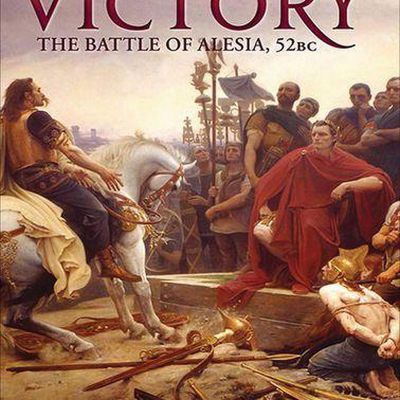The book “Caesar’s Greatest Victory: The Battle of Alesia, Gaul 52 BC” by John Sadler and Rosie Serdiville tells the story of one of Julius Caesar’s most amazing victories, who, despite being outnumbered by the Gauls, was able to stand up to and defeat the enemy at Alesia. The book was published by Casemate Publishers.
However, the book does not only tell about the siege of Vercingetorix and the rivalry between Roman troops and two Gallic armies, but focuses on presenting the entire context of the events and the genesis of the clash.
The publication begins with the authors’ thanks, indicating the sources and scientific works on which they were based, and indicating that the book is primarily intended to supplement the knowledge about the battle of Alesia, which, according to the authors, has still not been sufficiently described. The reader also receives a list of events related to the relations of the Romans and Gauls and the life of Caesar.
The actual content of the book begins with an introduction and nine chapters, which allow the authors to gradually describe subsequent issues. The first chapter focuses primarily on the presentation of Alesia, the likely location of an ancient city (Alise-Sainte-Reine), a discussion on this topic and the creation of Vercingetorix as a national hero in 19th century France. The second chapter focuses on the description of the Roman army, formations, legionary life, fighting style and training; the third describes the Celts and Gauls, incl. focusing on tribal divisions, commerce, society, construction; the fourth deals exclusively with the martial arts of the Gauls. Chapter five describes Caesar’s career, his rise to governorship, consulate and combat in Gaul in 58-52 BCE. Chapter six is a description of the figure of Vercingetorix. Chapter seven tells about the withdrawal of Vercingetorix and his army to Alesia, whom Caesar gradually surrounded by ramparts, thus wanting to subject the enemy to starvation. Chapter eight describes the battles between Caesar’s army and Vercingetorix’s army and the powerful Gallic forces that came to the rescue of the besieged commander. The last chapter is the authors’ deliberations on the battle, the characters of Caesar and Vercingetorix, and references to more recent events.
At the end of the book, you will find attachments: a numerical list of troops during the battle of Alesia and hints on visiting Alesia and the surrounding area. We also receive a dictionary of Latin phrases, an index of the words used, a bibliography, footnotes as well as photos, illustrations and maps.
The book is really a very interesting compendium of information about Caesar, his activities, and above all the Gallic War. Ancient sources tell us that Caesar’s nearly ten-year military campaign in Gaul, Germany, and Britain was a great victory for the Roman weapon and genius of Caesar. The Roman historian Velleius Paterculus claims that a total of 400,000 enemies were killed, and much more were taken prisoner. It is worth emphasizing, however, that the above-mentioned numbers did not apply only to armed men, but also to civilians, as in the case of the Helvetians. It is inconvenient that one direct source of information about the events in Gaul are the writings of Julius Caesar, who tried to show himself in the best possible light.
However, as modern researchers claim, Caesar began the invasion of Gaul primarily for economic reasons and to gain glory. Caesar, while still in Rome, had to borrow money from many people in order to develop his political career, what partially motivated him to conquer Gaul. As the governor of three provinces: Illyria, Pre-Alpine Gaul and Transalpine, he used tribal movements, incl. Helvetii to intervene in Gallic matters.
Vercingetorix, who is the second most important character in the book, was the son of one of the Gallic nobles, a Celtillus, who was accused of trying to claim himself as king of the Arverni and was then killed. Vercingetorix was the one who managed to come to terms with many Gallic tribes and act in a coordinated manner against the Romans. There is a thesis in the book that if Caesar had encountered more organized Gaul’s resistance at the beginning of his hostilities in 58 BCE, to be would force him to abandon his plans for conquest.
In summary, the book “Caesar’s Greatest Victory: The Battle of Alesia, Gaul 52 BC” is a really interesting work that thoroughly describes not only the battle of Alesia, but the Gallic War and issues closely related to it. The authors base their work on numerous ancient sources, research works and books. They show us the statistics given by Caesar, which they also try to adapt to more real numbers.
From the reader’s perspective, the only thing that disliked me was the collection of footnotes at the end of the book; it is much better to place them directly below the content at the bottom of the page. I am also unable to evaluate the book edition, because I read it in electronic form.
For those interested in ancient history, the book is a very pleasant proposal. Readers who are not fully familiar with the history of Rome will also have no major problems with finding themselves in the content, as the authors present the battle in a very broad historical context.


